At SalesBread we prefer to use this approach to lead generation :
- Send an ultra-personalized connection request
- Follow up and ask for a meeting
(The reason? We are still seeing better replies with direct messaging on LinkedIn. On average, we are seeing 45% connection rates, 39% positive reply rates, and 1 lead a day. )
InMails should be a supplementary approach to the above strategy. Truth is, Inmail (like cold email) is just another way to start a conversation with a potential lead.
According to a LinkedIn learning course, InMail has an average response rate of between 18-25%.
So there will be a percentage of your target market who will be responsive to InMails.
But if you aren’t getting the responses you want from direct messaging, then by all means use InMails.
In this article, we will share some of our best InMail message examples and some tips for getting more positive replies from InMails.
(And if you don’t have the time or expertise to find qualified prospects, hop on a free 15-minute strategy with SalesBread. Let’s see how we can help you.)
LinkedIn Inmail Templates
Below are some message templates you can use in your own outreach. Feel free to adapt them as you need to.
Example 1: Don’t forget your “value add”
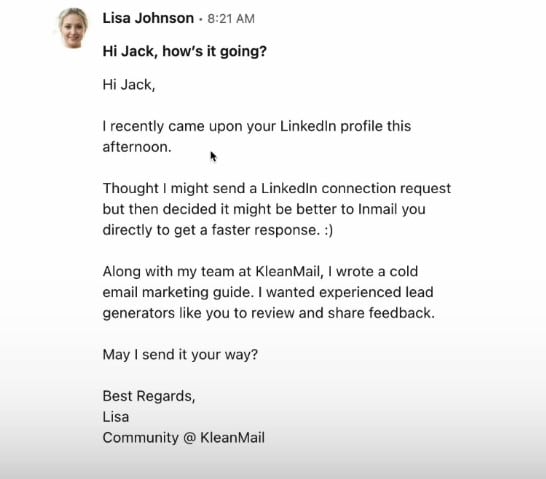
The above InMail isn’t perfect. For example, don’t send an InMail with a subject like:
“How’s it going.”
Rather, write your copy first and then think of a subject line that will capture your prospect’s attention.
Next, we noticed that there was quite a bit of fluff in the first two sentences. Be very specific and take out anything in your InMail that doesn’t add value to the prospect.
So we shortened the message down to this:

Then we also noticed, nothing was in it for us… (the reader.)
Remember to think about what’s in it for the prospect.
So they wanted us to read their guide, but we weren’t sure why.
If they had maybe mentioned one value proposition, it would have generated a better response.
The InMail could have gone like this:
Subject: {{Curiosity grabbing subject line}}
Body: {{First Name}} Along with my team at {{company name}} I wrote a cold email guide. We are going to mention SalesBread in this guide if you provide feedback. This guide is going to be shared with {{50 000 email subscribers…}}
{[Signature}}
The writer could have mentioned value ads like:
“We are going to mention SalesBread in this guide if you provide feedback. This guide is going to be shared with 50,000 email subscribers…”
Or:
“We are going to provide a backlink to SalesBread on our website, we have a domain rating of 80. This will help you generate more traffic.”
Or:
“We would like to add you to our partnership page directly on our website so that we can refer our clients to SalesBread whenever they ask for consulting services.”
These value ads make it much easier for the prospect to respond because there is something in it for them.
Remember to have a very clear CTA
Whether it’s asking the prospect to read a quick one-page cheat sheet and offer feedback in exchange for something of value.
Example 2: “Make the message about the prospect”

Subject: Trying to reach you
Body: {{First Name}} I wanted to reach you regarding your courses on Udemy. There is a big opportunity here for you at LightSpeed. If we can help your training be more immersive and help you generate more revenue, would that be of interest?
{[Signature}}
P.S: This is how we helped {{company}} generate {{X amount of revenue}} {{Share link to a case study}
Notice how the writer doesn’t talk about their product or service the entire time. They give enough context, just so that the reader knows what the message is about, and then they offer a value add. “If we can help your training be more immersive and help you generate more revenue, would that be of interest?”
Example 3 “Don’t add too many benefits at once”

Subject: {{Website link}}
Body: {{First Name}} After reviewing your profile, I thought that you would be a great fit for our online Master of Healthcare Leadership program.
Some benefits are: {{List benefits}}
- Studying at a university that is ranked nu 28 in the nation
- Networking with industry leaders in healthcare
- Program completion in less than 20 months
- No standardized testing required
Would love to hear from you, let us know if you would like any more info.
{[Signature}}
In the above InMail example, you will notice that the benefits of the program have been listed in bullet points. We suggest mentioning one benefit (your best), instead of all at once.
This allows you to mention more benefits in your follow-ups.
Example 4 “Keep it short”
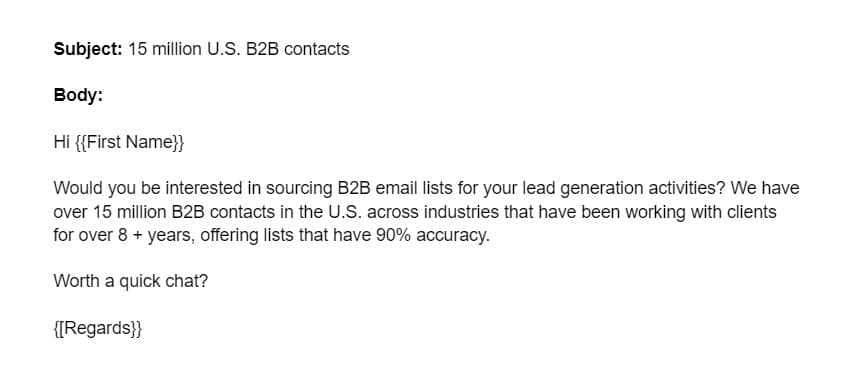
Shorter InMails perform better than longer ones. If you can, keep your message short; Just 2–3 sentences.
Example 5 “Do your research”
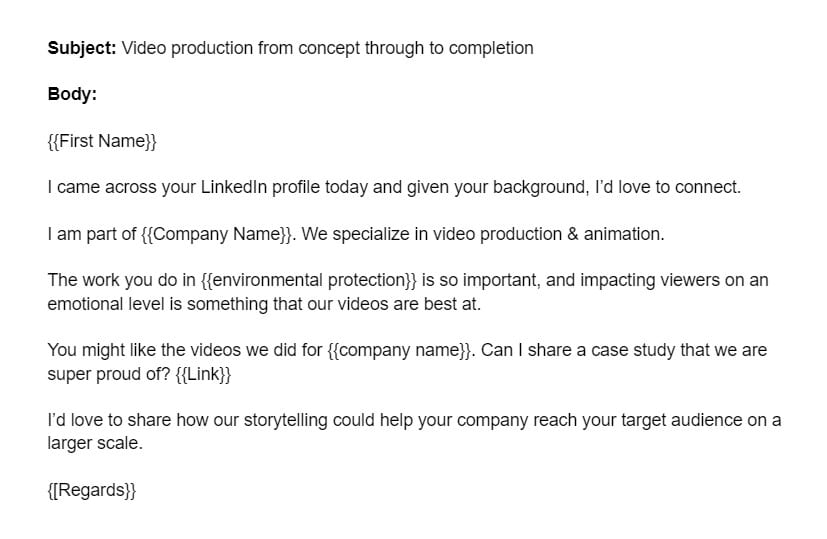
Subject: Video production from concept through to completion
Body: {{First Name}} I came across your LinkedIn profile today and given your background, I’d love to connect.
I am part of {{Company Name}}. We specialize in video production & animation. The work you do in {{environmental protection}} is so important, and impacting viewers on an emotional level is something that our videos are best at.
You might like the videos we did for {{company name}}. Can I share a case study that we are super proud of? {{Link}}
I’d love to share how our storytelling could help your company reach your target audience on a larger scale.
{[Regards}}
Notice how they use personalization? The person took the time to research the prospect and saw that they worked in environmental protection. They also mentioned how their videos could move audiences on an emotional level.
They also mention a case study and a link to a video that they made. The CTA mentions how they could help the particular company reach its target audience on a larger scale.
Example 6 “Find common ground”
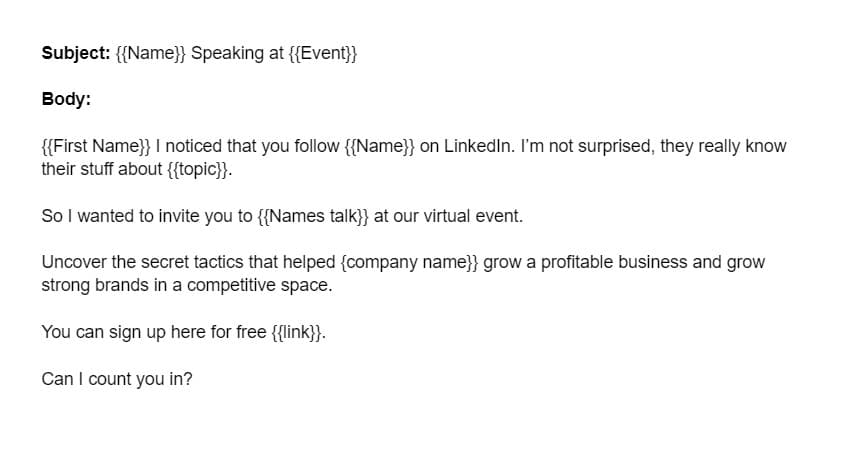
Subject: {{Name}} Speaking at {{Event}}
Body: {{First Name}} I noticed that you follow {{Name}} on LinkedIn. I’m not surprised, they really know their stuff about {{topic}}. So I wanted to invite you to {{Names talk}} at our virtual event.
Uncover the secret tactics that helped {company name}} grow a profitable business in a competitive space.
You can sign up here for free {{link}}.
Can I count you in?
Notice the value add? The prospect is already interested in the person who will be speaking at the event. Adding in a free signup is a slam dunk. Once again, prospect research is important here, especially for sales outreach. When you add in personalization, prospects will be more willing to engage with you.
Example 7 “Mention stats and offer free demos”

Subject: White-label solution
Body: Hi {{First Name}}. The automated lead generation market is expected to reach $102 billion by 2024. We want our SaaS partners to succeed by making it easy to white-label their platforms and grow their profits.
Our clients have seen a quick bump in their monthly revenue. Would you be interested in White-label solutions?
I can walk you through how it works. Here’s a link {{link}} to a quick video explaining how it works. Please let me know if you would like to book a free demo.
{{Your name}}
Offering free demos can also be helpful for your ideal customers. Remember to add any stats as well that can back up your claims. For SaaS in particular, you can add case studies or testimonials into your text.
Example 8 “Add a credibility boosting testimonial”
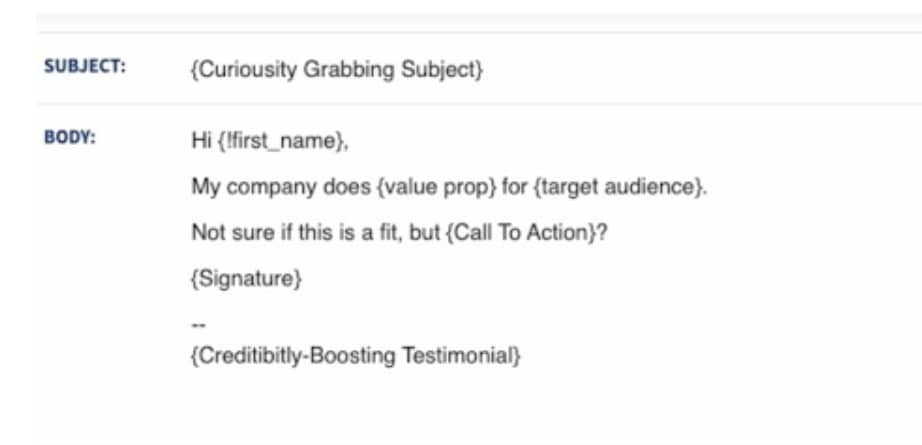
Subject: {{Curiosity Grabbing Subject Line}}
Body: Hi {{First Name}}
My company does {{value prop}} for {[target audience}}.
Not sure if this is fit, but {{call to action}}?
{{Signature}}
{{Credibility boosting testimonial}}
The LinkedIn InMail template above is getting a 14% response rate, and this is how we structured the message:
- Write a curiosity-grabbing subject line.
- You will then need to write a short, personalized message (for personalization you can take a look at their LinkedIn profile for info) with a call to action at the end.
- We then add in a testimonial of the service and follow up with meeting requests. This starts the conversation off easier.
Do you notice how short the message is? It’s to the point but also raises curiosity, without going into a sales pitch.
Example 9 “Ask questions”

Subject: {{Curiosity Grabbing Subject}}
Body: {{First Name}}, I’m looking for a {{role}} contact on your team to discuss {{topic}}.
Are you the right person to speak with, or can you point me in the right direction?
{{Signature}}
Here is another example of one of our recent campaigns. This campaign is getting a 22.3% reply rate. As you can see in the template, the message is short and raises a person’s curiosity.
You are encouraging them with questions for easy outreach.
Example 10 “Look for referrals”

Subject: {{Curiosity Grabbing Subject}}
Body: {{First Name}}, based on your profile, {{Why you contacted them}}. {{Custom Compliment for prospect}}
Let me know what works for you for a call.
Curious to {{insert purpose of call & benefit to prospect}}
{{Signature}}
This last example is a bit longer than the above messages. And just for your information, this message does not get as high a response rate, but it does go into the “ask” quite early on.
We usually get a 12.5% reply rate for this kind of message.
You can use this template for decision-makers, whereas the templates above are great for getting referrals.
With this specific message below, you would still use personalization, but you also ask for a call.
In the message, you will need to explain why you are contacting them, and why you can be of benefit to them.
Also, notice that the message is mainly about the prospect and not about your sales pitch.
Pro-tip for this strategy: This type of messaging needs tons of personalization when asking for a meeting. It’s a lot more work, (as you will need to do research, and even find commonalities to get the personalization perfect.) but you will get the results you’re looking for faster if you’re willing to do the extra work.
After each of these messages, you can add a pre-filled automated response that the prospect can just click. We like using “I’d like to learn more” as a response.
This is one that we received from a recent prospect:
“Hi, Thanks for reaching out. I’d like to learn more.”
Tips for sending InMails
Use the “open InMail” setting applied to a prospect’s profile
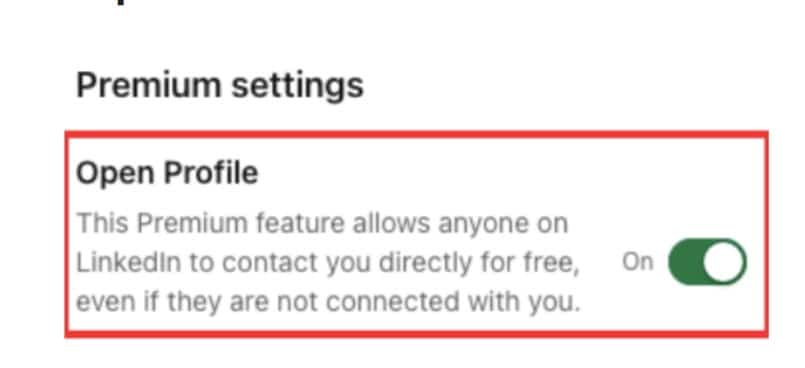
LinkedIn makes it really easy for us to know who is open to getting InMails.
(This is something that the cold email world would love if there was a magic button to show you who was open to getting your emails.)
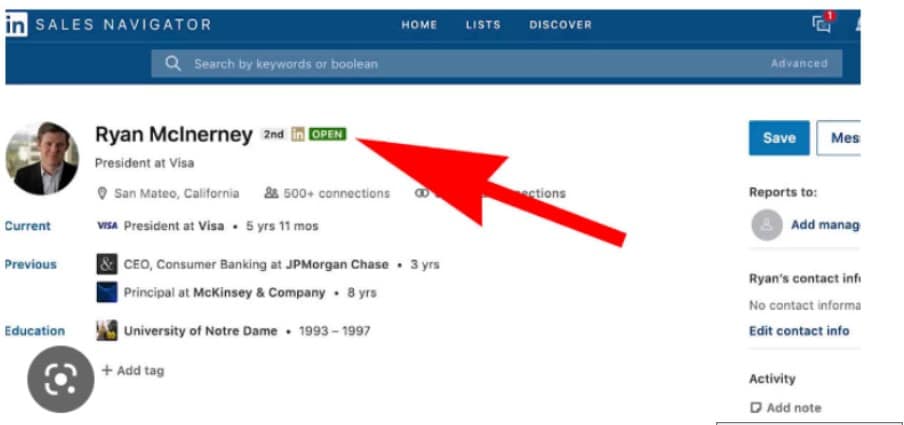
Open InMail is basically a toggle that allows anyone to contact you on LinkedIn for free, even if they aren’t in your network.
Always add value to your copy
When thinking about what to write in your copy, always think about what’s in it for the reader.
If each sentence packs a punch and adds something of value to your reader, the chances of them continuing to read your message will be greater, AND they will most likely respond.
Use the 90/10 rule. Speak about the prospect 90% of the time and only 10% about yourself, just for context. Try to put yourself in the reader’s shoes and think about how you would respond to the message.
Never ask for something without offering something in return. For example, if you would like the reader to check out a guide, offer them something like 10 free backlinks.
Keep your InMails short and to the point
InMails can have a 200-character count for your subject line and a 1900-character count for the body of your InMail – This doesn’t mean though that you should use the entire character count.
Remember, people are busy.
If they see a long passage of copy, they aren’t going to read it. LinkedIn suggests only sending messages that are about 100 words.
So keep your InMails short and to the point.
Write your subject lines after you have written the copy
Subject lines should also be short and to the point. If you can limit it to one or 2 words.
For example: “Quick Question.”
We recommend writing a subject line after you have written your copy, it’s just easier to think of something specific and to the point.
Don’t have a salesy pitch in your messages
A sales pitch is the fastest way to make your prospects hit delete.
Don’t use a sales pitch.
Rather, use the InMail as a way to get your foot in the door to continue a conversation. Or direct the reader to something very specific.
You only have one shot with an InMail because you can’t follow up
Because InMail only has one touch, we recommended adding one of the most important pain points that your prospect is facing.
Mention 2 benefits of your product/service, and maybe 2 social proof examples.
Don’t just name-drop, but rather mention 2 companies that you helped and share the results gained for them in the same sentence.
This will pack a stronger punch.
Have one easy Call to Action
Have one very clear and easy CTA. This will ensure that you have the best chance of getting a response in one single touch.
You need to be very clear about what you would like the prospect to do.
If you are vague, they won’t respond.
When we say use an easy CTA, we mean make it as easy as possible for your prospect to respond.
If not – you’re doing it wrong.
If you’re asking for a 15-minute call over InMail, you’re going to get a much smaller response.
What’s the goal of an InMail?
It’s just to start a conversation. What we see works best as SalesBread, is to ask to make the next easiest baby step.
Which could sound like this:
- Can I expand on this more?
- Are you interested in XYZ?
- Would you like to find out more?
Ideally, you would like them to reply with a one-word answer, like “yes.”
We always ask for a quick chat in our LinkedIn follow-ups, but this doesn’t work well with InMails.
Don’t use automation for everything
We have noticed that many InMails are automated. It’s okay to use some automation, but if a prospect replies, we suggest having a salesperson respond in real-time.
In this way, if the prospect has any questions, you can have a human answer the questions.
Use this formula for reaching out to qualified leads
Build a list of your ideal target audience
Before you send an InMail, you need to make sure that you’re reaching out to the right kind of prospects, who actually need what you’re selling.
So to do this, you have to look at data.
Which companies have purchased your product/service from you within the past 6 months?
Then, ask yourself, what do these companies all have in common?
- Which industries are buying from you? Are they all in health & wellness? Or tech?
- Where are they located? USA? Europe? 100 miles from California?
- Which decision-makers are buying from you? Is it the CEO of the company? Marketing managers?
- Have these companies been funded?
- How big are the companies that are buying from you? 10–20 employees? 100+?
- Have these companies all been featured on a podcast? Or do they make use of podcasts for marketing?
Eventually, certain patterns will begin to emerge that will allow you to build look-alike lists of prospects.
Research prospects, so that you can write a personalized message

Let’s say, for example, that you would like to reach out to the above person via InMail.
Maybe you figured out that your best sales come from SaaS content marketers.
Here’s what you do…
Look at the prospect’s LinkedIn profile and find something to either:
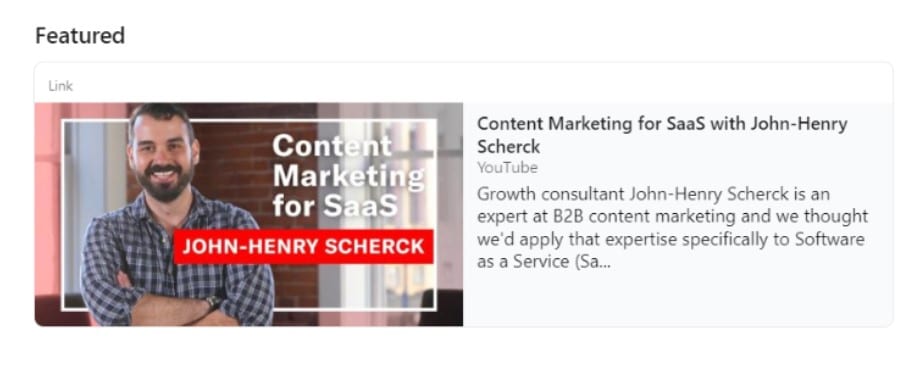
- Compliment the prospect on
- Mention a shared commonality
- Ask a question
This method is known as CCQ.
When you mention something personal in your InMail, it usually piques the prospect’s interest.
Why?
Because they know it’s not some random spam InMail that’s being sent to hundreds of other people.
This will help your InMail stand out from all the thousands of messages that are spammy.
For example, if you look at the profile above, you could compliment the prospect and say:
“John, loved your YouTube video on (XYZ.)
Thought I’d reach out because I’m curious to hear how {{company name}} solves {{pain points?}} For reference, our company does {{XYZ (mention how you solve pain points }}.
Would love to hop on a quick call to chat about XYZ. Let me know if this might be something on your radar.
({{Your name}}
Use an easy to “respond” Call to Action
We always ask for a booked sales call in all our outreach messages, but as we mentioned earlier this doesn’t work with InMails…
Use a CTA that tells the prospect exactly what you’re looking for from them, and paves the way for further conversation.
You could even say:
- Here’s a link to my website
- If you would like to learn more, reply with a yes.
- Is this worth a quick conversation?
What’s the cost of sending LinkedIn InMails
There are 3 InMail options:
- Free InMails—You can send messages to members with open profiles or in your current network.
- Paid InMails—These are available through LinkedIn’s subscription plans
- Sponsored InMails—These are used to send bulk messages to a targeted audience that appear as a “LinkedIn Offer” in recipients’ inboxes.
The number of LinkedIn InMail credits you receive each month depends on which subscription you have.
- Premium Career: 5 credits per month
- Premium Business: 15 credits per month
- Sales Navigator Core: 50 credits per month
- Recruiter Lite: 30 credits per month
Here’s the maximum amount you can send per month:
Maximum InMail credits by your account type are:
- Premium Career: Up to 15 credits
- Premium Business: Up to 45 credits
- Sales Navigator Core: Up to 150 credits
- Recruiter Lite: Up to 120 credits
As on your Sales Navigator subscription, you can get:
- 50 InMails/month with LinkedIn Sales Navigator Core Professional
- 50 InMails/month with the Sales Navigator Team Edition
- 50 InMails/month with the Sales Navigator Enterprise
If you need to, you can purchase InMail credits above your monthly usage. They cost $10 each, which can get pretty pricey.
Remember to first use direct messaging and then InMail as a supplementary option.
Ready to give this strategy a try?
If connection requests aren’t getting the replies you want from prospects, by all means, try InMail.
With some of our LinkedIn outreach campaigns, we are receiving great response rates from using InMails.
We still prefer using connection requests first, though.
If you’re interested in learning more, please read this article, it explains exactly how we find 1 guaranteed sales lead per day for our clients.
Or book a free 15-minute strategy session below.
Ready to give this strategy a try?
If connection requests aren’t getting the replies you want from prospects, by all means, try InMail.
With some of our Linkedin outreach campaigns, we are receiving great response rates from using InMails.
We still prefer using connection requests first though.
If you’re interested in learning more, please read this article. It explains exactly how we find 1 guaranteed sales lead per day for our clients.
Or book a free 15-minute strategy call below.
